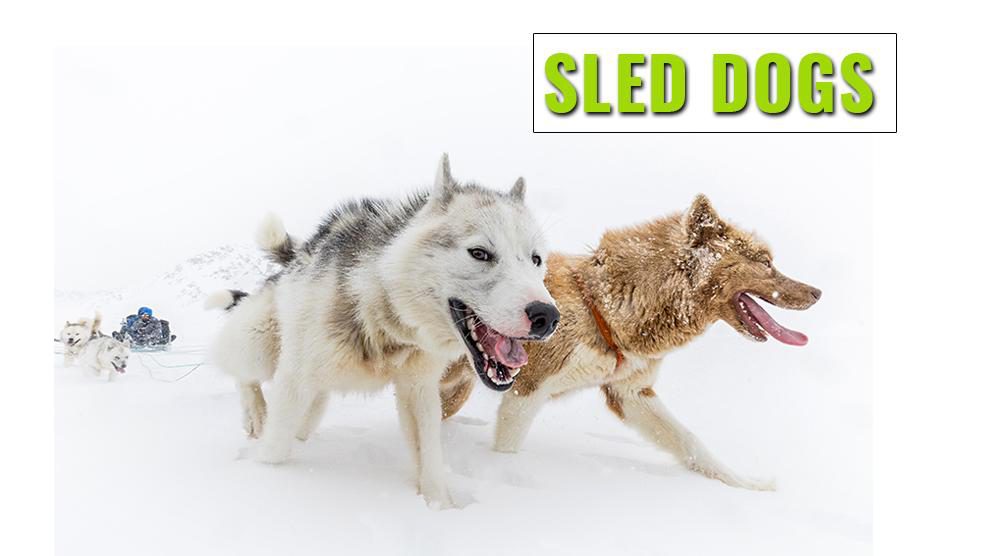Dog Pregnancy Calculator And Timeline
Never fall for their unpolished, innocent looks. A combination of various heritage traits provides sled dog breeds their unquenchable spirit to run, a search for different places, and an unbreakable desire to work tirelessly.
Sled dogs participate in various exciting expeditions- from transporting explorers to racing in the famous Iditarod trails. These dogs always reside in a special way in our imaginations and hearts.
Not all dog breeds can survive bitter cold blizzards, run continuously for miles and miles across the vast stretches of tundra, and withstand the intensity of harsh long-distance racing.
The most priceless feature is their ability to work as a team.
In recent times, sled dogs are pride in every sense as they continue to work alongside humans, carry equipment, and still race competitively. Here is a list of most preferred sled dog breeds.
Alaskan Husky
- Height – 23-26 inches
- Weight – Males- 40-60 lbs, Females-35-48 lbs
- Lifespan – 12-15 years
History
The Alaskan Husky is said to have originated from mixed-breeding of different dog breeds. The main task is to produce a top-class dog, so the ancestry will take into account the work the Alaskan Husky will depend on.
A racing Alaskan Husky, for example, can be a hybrid of a purebred dachshund and husky, based on the race requirements. People mainly employed this breed in the Arctic region for transportation purposes. These sled dog breeds are bred as working dogs as they are fast learners.
Alaskan Huskies were initially bred from native Inuit dogs. Other breeds used in producing Alaskan Huskies include German shorthaired pointer, Greyhound, Siberian Husky, and the famous Eskimo dogs.
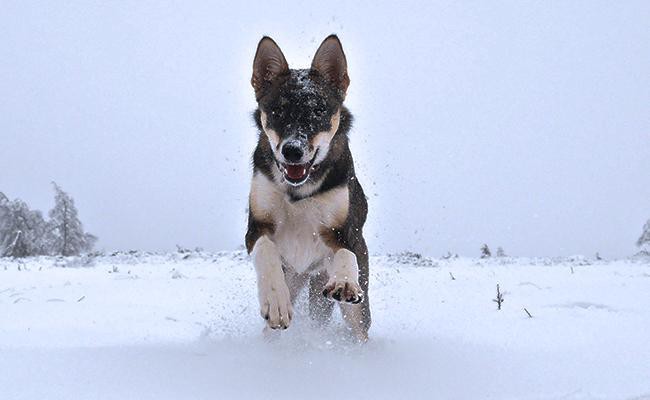
Appearance
Siberian Huskies and Alaskan Huskies look almost the same. They come in any pattern and color depending on the breeder’s reputation.
Alaskan Huskies have brown eyes predominantly while Siberian Huskies have blue or brown eyes or a combination of both.
Retrieving and swimming capacity is not present genetically in this breed but can be trained.
A good vision and a powerful nose are common to this breed.
Temperament
Enthusiastic cuddlers. Alaskan Huskies are good jumpers and they can cross six feet high fence effortlessly.
They are friendly with other dogs and humans as well.
Not easy to housebreak, and naughty, an Alaskan Husky is not for a novice dog owner.
Care
Shedding occurs only once a year which is part of the natural defense mechanism of hair fall and infrequent bathing is recommended. The Alaskan Husky needs constant exercise and a large home with a big yard to run.
Health Problems
Easily prone to genetic problems, health issues include wheezing trouble, hypothyroidism, and progressive retinal atrophy.
Alusky
- Height – 26-28 inches
- Weight – 60-100 lbs
- Lifespan – 10-15 years
History
The Alusky’s are a crossbreed between an Alaskan Malamute and a Siberian Husky.
This mixed breed will carry traits from both its parents, and it is not at all easy to guess how much each parent will contribute to the final product.
Alaskan Malamutes are ancient and earliest dog breeds.
The Alusky dog gains its adamant nature for the Alaskan Malamute parent and this forces breeders to consider constant mental stimulation every now and then.
Alusky’s are mainly used for racing, freight hauling, search and rescue, carting, and sledding.
Appearance
The Alusky is medium-large sized dogs. They have a sturdy, compact body that is not so long.
Siberian Huskies have blue eyes and this dog breed can have either the blue eyes or the brown eyes or a combination of the two.
They have narrow muzzles, wedge-shaped long ears, dark noses, and a fluffy tail. The coat appears thick and dense.
The Alusky have different fur colors ranging from salt and pepper, golden, gray, light brown, silver, white, cream, brown, and red.
Temperament
An Alusky dog will be playful, outgoing, loving, loyal, and charming. These dogs love greeting and meeting new people, and they move well even with strangers.
The Alusky have a strong prey instinct. Being social by nature, they can become destructive and bored if not given due attention.
Care
These dogs are prone to boredom quite easily and give them toys to play. Brushing the coat daily will reduce the amount of shedding.
Bathing is only necessary when they are dirty and Alusky’s need for early training and socialization.
Check the ears weekly once and apart from that clip the nails and brush them twice a twice minimum.
Health Problems
Like most crossbreeds, the Alusky ’s are strong and healthy. They are prone to hip dysplasia, ear infections, and eye problems.
Alaskan Malamute
- Height – 23-25 inches
- Weight – 75-85 lbs
- Lifespan – 12-15 years
History
Alaskan Malamutes are from Alaska. Initially popular amongst the Inuits tribe, the Alaskan Malamutes were mostly used for heavy sled pulling and large game hunting.
These dogs were not overbred because of food shortage.
This breed takes its roots from the popular Spitz family. Alaskan Malamutes are closely related to the Elkhound, the Finnish Spitz, the Samoyed, the Chow Chow, and the Akita.
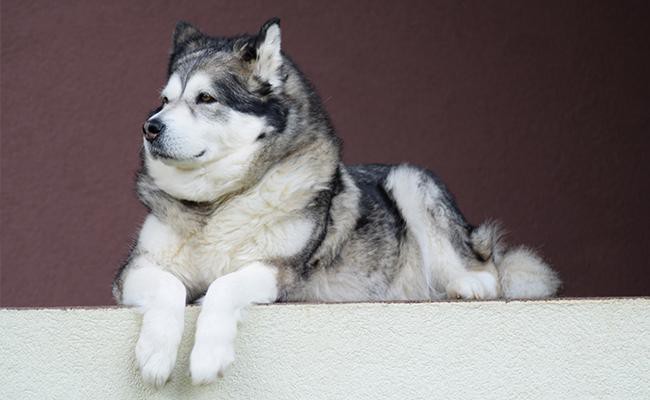
Appearance
Alaskan Malamutes are seen in various colors that include white, silver and white, seal and white, sable and white, red and white, and black and white.
Some Alaskan Malamutes have gray or black markings. These dogs have strong legs, big muzzle, triangular ears, and a broadhead.
Alaskan Malamutes also have strong shoulders and a deep chest. The coat appears double layered and thick for protection.
Temperament
Alaskan Malamutes are affectionate pets. Malamutes require plenty of physical and mental stimulation to keep them in a healthy shape.
These dogs are courageous and loyal but can be stubborn and strong-willed at times. Like their Spitz like counterpart Chow Chow, sometimes they are quite aggressive towards same gender dogs.
They howl instead of barking and are vocal with their family members.
Care
Alaskan Malamutes sheds quite heavily at least twice a year. This dog needs regular brushing with a metal comb and a pin brush.
It is vital to groom under their neck and arms and bathing can be done once a month.
Trim their nails and clean the ears on a regular basis.
Health Problems
Alaskan Malamutes are prone to osteochondrodysplasia (OCD), cataract, canine hip dysplasia, eye problems, and hypothyroidism that affects the immunity of thyroid glands as well.
Canadian Eskimo
History
The Canadian Eskimo Dog has existed for more than 3000 years in the Arctic. Canadian Eskimo Dogs are called Gronlandshund, Qimmiq, and Inuit Husky.
This breed was mainly bred to take part in hunting and pulling sleds.
These dogs were taken care of by the local Inuit woman and were, therefore, gentle and experienced around children.
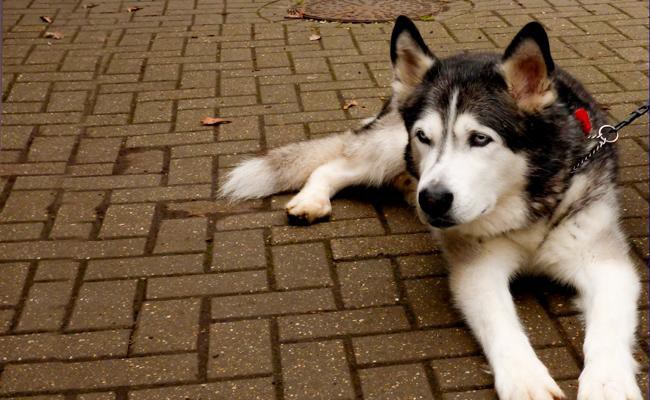
- Height – 22-28 inches
- Weight – 60-105 lbs
- Lifespan – 10-15 years
Appearance
Similar to a Siberian Husky, Male Canadian Eskimos Dogs are powerful and large. Around the Canadian Arctic region, these sled dog breeds are used for sled pulling mainly.
Females have a shorter coat and both the sexes have dense and thick hair that helps them manage the harsh conditions of the Canadian Arctic.
Males are popular for their manes and the eyes are actually almond-shaped. They are either amber or dark brown in color.
Temperament
Canadian Eskimo dogs are highly social with their family members. These dogs are pack oriented and will steadily challenge their guardians.
Canadian Inuit dog is mostly aggressive to dogs and affectionate towards people.
Being high-active dogs, they are bad diggers and chewers.
Care
Canadian Inuit dogs are known to howl to grab attention. They do well in an environment where they are put with peer Eskimo dogs.
Never bring other pets such as reptiles, birds, rodents, and cats close as they may see them as food.
These dogs fight within themselves to establish supremacy and they do well when kept separately.
Health Problems
The Canadian Eskimo dogs are susceptible to-
- Gastric Dilation-Volvulus
- Addison’s Disease
- Hip Dysplasia
- Hepatitis
- Allergies
- Cataracts
- Cryptorchidism
Consult your local vet if you find your pet looking uncomfortable.
Chinook
- Height – 22-28 inches
- Weight – 60-105 lbs
- Lifespan – 10-15 years
History
The exciting gem of Wonalancet, New Hampshire, the United States, the Chinooks is amazing working dogs.
They are devoted family pet well-known for readiness to please, patience, and intelligence. One of the scariest pure dog breeds, the Chinooks were once literally going extinct.
Arthur Walden developed the Chinook. As his base stock, he used a mastiff-range dog and one of the descendants of Peary’s Greenland huskies.
Walden named him Chinook, the main dog of his team.
The puppies Walden bred were popular for their affectionate, warm, and sledding ability.
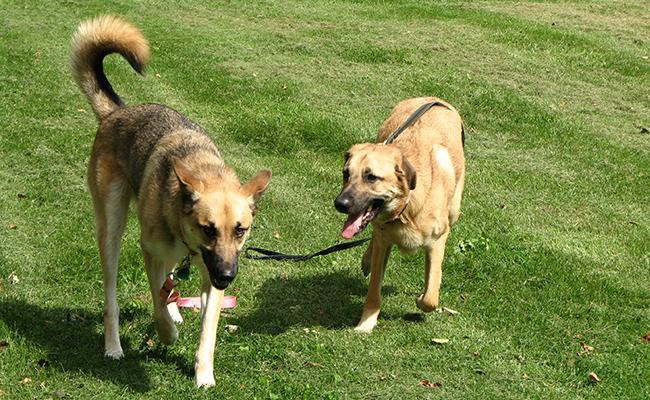
Appearance
The Chinooks are substantial and muscular, with males standing around 66 cms at the shoulder.
Female Chinooks are a bit small in size compared to males.
These dogs were developed for two main purposes- run like sled racers and perform as freighting dogs as well.
Almond eyes, with a shiny twinkle, and a personality with unflinching dignity, the Chinooks are tawny-coated.
Temperament
Chinooks are people-loving, calm dogs with a special love for children. These dogs are highly trainable who never miss an opportunity to please their owner.
They are good at herding, search and rescue, agility, obedience, carting, and sledding. Chinooks need consistent exercise and they are not busy dogs as such.
Care
The Chinook’s double coat is simple to handle. Weekly brushing removes all the loose hair and dirt.
Daily brushing will be a necessity during the shedding season. This happens more with neutered and spayed animals.
You have to frequently trim the nails, as long nails can cause problems while running and walking.
These dogs require lots of energy and they rely on play and exercise.
Chinooks bond closely with their masters, they make excellent companions on camping trips, bicycle rides, hikes, and long walks.
People bred Chinooks to excel at lure coursing events, tracking, rally, obedience, and agility.
Health Problems
The Chinooks are healthy, robust breed, but they are still susceptible to certain health conditions.
They are prone to
- Allergies
- Gastrointestinal issues like bowel and gastro problems
- Cryptorchidism
- Hip dysplasia
Some dogs also suffer from a disease called “Chinook seizures”. Check their ears on a regular basis for infection and brush them as often as possible.
Samoyed
- Height – 19-21 inches (female), 21-23.5 inches (male)
- Weight – 35-50 lbs(female), 45-65 lbs(male)
- Lifespan – 12-14 years
History
Samoyed, a group of nomadic people who migrated to one of the coldest places on earth, Siberia, a thousand years coined the breed Samoyed.
The Samoyede tribes depended on various food sources including reindeer.
These nomadic tribes bred dogs for working under harsh conditions and the Samoyede people huddled and lived in tents with their dogs.
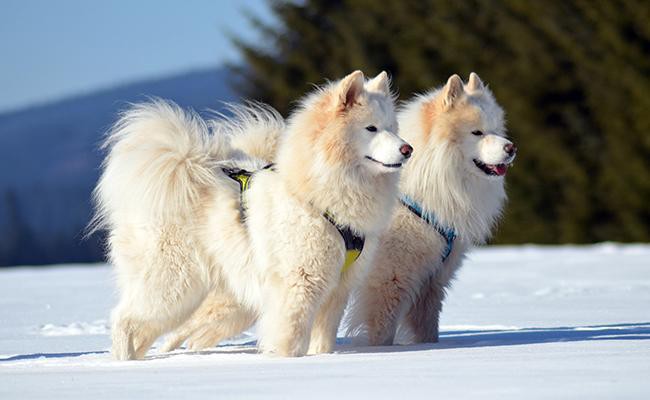
Appearance
The most enchanting of all sled dogs, Samoyeds, were developed for hard work. Samoyeds are graceful dog standing anywhere between 19 inches and 23 inches.
Accustomed to cold conditions, thick all-white rich coat, tireless, and strong, the Sammies are definitely beautiful dogs.
The natural shape of their mouth prevents Sammies from drooling and they are brilliantly functional.
Temperament
The Samoyed is dependable and gentle in mind and heart. This playful dog is happy, lively dogs who love people.
These dogs are brilliant with children and family members and they do not guard dogs.
Being excellent family dogs, Samoyeds tend to love those who feed and play with them on a regular basis.
Samoyeds are always ready for a hike and are handy companions for outdoor people. Sammies are well-disciplined and make an excellent choice for most dog owners.
Care
The Samoyeds are not a good choice to live comfortably in a condo environment. A large farmhouse is the best choice.
Keep this dog mentally active with dog sports and ongoing training. If a Samoyed dog becomes bored, he’s is ready to chew himself to beat the boredom.
Samoyeds are popular for their profuse double coat. Daily brushing will remove loose hairs and dirt.
You can correct tangles and mats with a metal comb and slicker brush. The nails need trimming every three or four weeks.
Health
Samoyeds are healthy dogs and responsible breeders will test for a cardiac, eye, and hip dysplasia problems.
The Samoyed’s teeth need regular brushing and scheduled visits to the vet can help detect the most common medical conditions in canines.
These dogs are prone to various diseases and they include-
- Malignant lymphoma and other types of cancer
- Subvalvular Aortic Stenosis
- Progressive Retinal Atrophy (PRA)
- Diabetes Mellitus
- Hypothyroidism
- Samoyed Hereditary Glomerulopathy
- Hip dysplasia
- Glaucoma
Siberian Husky
History
The Siberian Husky’s breed ancestors were mainly from northeastern Asia. Chukchi tribes were raising dogs as companions and also as sled dogs.
The Chukchi people were lucky enough to maintain the quality of the sled dogs for a long period of time.
The dogs they actually bred were the real ancestors of the present-day Siberian Husky. Siberians made headlines when Seppala, a veteran musher, led a team of Siberian Huskies to Nome dubbed as the popular “Serum run.”
Balto, the lead dog on the final journey, caught world attention like no other dog to date.
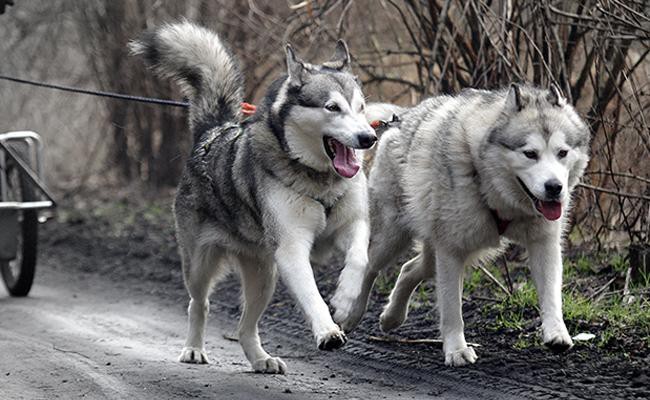
- Height – 20-22 inches (female), 21-23.5 inches (male)
- Weight – 35-50 pounds (female), 45-60 pounds (male)
- Lifespan – 12-14 years
Appearance
These dogs are medium dogs, fast and light on feet and elegant in action. The Siberian Huskies are stunningly compact with erect ears, and his gait is seemingly smooth.
They can carry the light load over great distances. His body proportions show the basic balance of endurance, speed, and power.
Temperament
The main characteristic personality of the Husky is soft and affectionate, but also outgoing and alert.
The Siberian Husky will never display the traits of a guard dog. He is also not aggressive or suspicious of strangers. they exhibit balanced temperament and well-socialized behavior like labs except for guarding traits.
His tractability, eager disposition, and intelligence make him a good companion and excellent worker.
Care
These dogs are good and efficient natural breeds. Siberian Huskies are amazingly self-cleaning dogs that seldom need to the bath.
Weekly brushings can help maintain the skin and coat in top condition. They have both guard hair and an undercoat.
The undercoat sheds twice annually.
Hire a professional groomer using a metal comb and a pin brush. Regular exercise can keep the dog both mentally and physically active.
Siberians were developed to run and being an adaptable breed, they can survive in an urban setting.
Health Problems
Huskies are a healthy breed and they are like other breeds, prone to specific health issues.
Common health problems faced by a Siberian Husky dog include
- Progressive retinal atrophy
- Corneal dystrophy
- Cataracts
Knowledgeable breeding practices confirm the good health of the dog.
Yakutian Laika
- Height – 21-23 inches
- Weight – 40-55 lbs
- Lifespan – 10-12 years
History
The Yakutian Laikas have recently developed a dog with a different history. Yakute people living in the Yakutia province bred these breeds.
They used the dogs for reindeer herding and hunting. In 98’, a group worked hard to reclaim this breed. In 2004, Yakutian Laika was finally recognized.
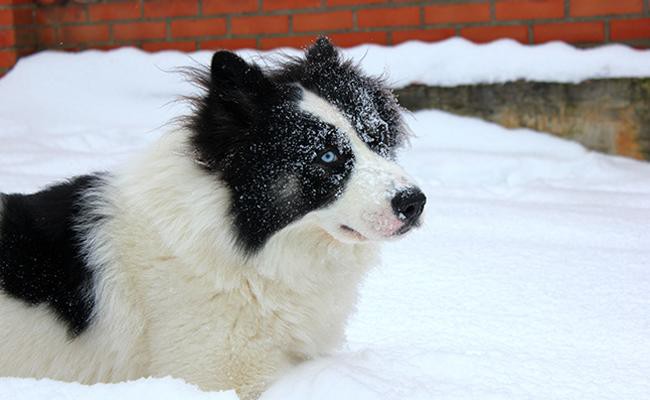
Appearance
Yakutan Laika is a well-muscled, compact dog with a thick skin. Fur remains well developed in almost all Laikas and males are stronger and sturdy than females.
Temperament
TheYakutian Laika remains one of the best faithful assistant and irreplaceable companion of a man. The dog remains a lively, devoted, and affectionate companion.
Yakutian Laikas are easy going with children but more reserved with strangers.
Care
These dogs experience heavy seasonal shedding. When shedding heavily, you better brush him on a daily basis.
We suggest a metal comb and a pin brush. Being an exceptional working dog, the Yakutian Laikas are naturally clean and excessive trimming is not necessary.
Clean his ears and trim the nails on a regular basis.
Health Problems
Yakutian Laikas are a strong breed and to ensure that they stay that way, it is the duty of breeders to check for different health issues.
They include
- Eye anomalies
- Bloat
- Elbow dysplasia
- Hip dysplasia
What Makes A Sled Dog Efficient?
Sled dog facts
A competitive musher( the one who drives or runs the sled) always chooses a sled dog after carefully analyzing several qualities.
Feet
Good feet are one of the most important aspects. Long-distance races put a lot of stress on the feet. Dogs, in general, with soft feet may find it difficult on the icy trail.
Boots may not work for all dogs, shorter races are difficult to win with booties.
Coat condition
A solid healthy undercoat provides the much-needed warmth and protects the sled dog from the harsh weather conditions.
Appetite
A healthy appetite is really crucial because choosy eaters might avoid some of the essential nutrients and this reduces their racing ability.
Instinct to train
The instinct to run and the ability to work and cooperate in harness is especially vital for a team’s progress.
Competition fitness can be induced with training and a mushing team will look for a sled dog that is ready to work with humans and other animals.
Give a pass to aggressive or antisocial dogs. Many trained sled dogs interact and participate in shows that involve tourists and fans year-round.
They select only sled dogs that are both smart and affectionate with people.
Ability to think independently
Lead dogs are the main cog in the wheel. They execute all the musher’s commands, maintain the right speed, and make sure the rest of the team is running in the right manner.
A healthy lead dog guides the team and has the ability to think independently as well.
Lead dogs should stop running when it encounters bad ice. Inexperienced mushers will find it hard to control experienced lead dogs during the race.
You May Like To Read:
Sled Dog Positions – Order Of Importance
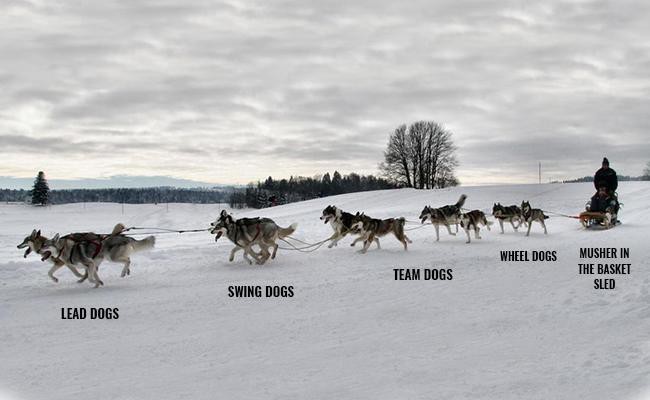
Functions of different sled dogs in the racing team
- Lead dogs – Sets the tone for the entire race, leads the pack carrying out musher’s commands, responsible for the right direction
- Swing dogs – Dogs that follow the lead dogs and their main duty is to follow turns
- Team dogs – The ones that actually pulls the material and control speed
- Wheel dogs – Pulls and steers the sled in the right way
- Basket sleds – Used by mushers, much lighter and stronger than toboggan sleds
Which Is The Best Sled Dog According To Experts?
- A natural instinct toward undue aggression is the main problem why Alaskan Malamutes are not favored anymore as sled dogs. They were one of the most sought after sled dog breeds previously.
- Another reason experts claim is that Alaskan Malamutes are not fast runners.
- Siberian Huskies are also overlooked.
- Many sled dog racers prefer Alaskan Husky, which carries the traits of both Malamutes and Siberian Huskies in recent times.
- To increase the speeds naturally, breeders mix Alaskan Huskies with English or German pointers. Greyhounds that are bred for gaming and racing are also mixed.
- Mixed pointers, hounds that are known for excellent speed and a strong sense of smell have also become part of marathon races. Obedient and intelligent Border Collies are also used for racing nowadays.
- A good sled dog should actively communicate with the general public more than anything else says a sled dog expert.

